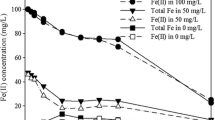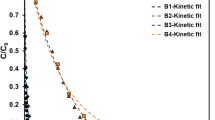Abstract
The mobility and bioavailability of selenium is a major health and environmental issue and a main concern for geological disposal of high-level radioactive waste. Chemically and/or microbially mediated oxidation of insoluble Se-bearing particulate, such as iron selenides, to dissolved and mobile phases controls the transport and distribution of Se in the environment. The oxidation of ferroselite (FeSe2) by ferric iron was investigated in anoxic conditions. The redox reaction can be represented by: FeSe2 + 2Fe3+ = 2Se0 + 3Fe2+. Kinetic studies indicated that the reaction can be described by second-order rate law, with rate constants of 0.49±0.01, 0.85±0.02, 1.84±0.04, and 3.29±0.13 L mol−1 s−1 at pH 1.62, 1.87, 2.23, and 2.49, respectively. The positive correlation between reaction rate and pH implies that diffusion of Fe3+ oxidant to the mineral surface is the rate-determining step. The strong reactivity of FeSe2 towards Fe3+ suggests that ferric iron may play a significant role in FeSe2 oxidation process (e.g., by Se4+, O2, etc.) and Se0 should be the first reaction product. Also, it was shown that the reduction rate of Fe3+ or Se4+ by pyrite (FeS2) can be significantly increased in the presence of FeSe2, suggesting a stronger reactivity of FeSe2 compared with pyrite. The results obtained extend our knowledge about the subtle interaction between Se, pyrite and iron selenides in the environment, and give insight into the transfer of selenium from iron selenides to bio-available selenium (i.e., selenite and selenate) in the Se-rich environment.
Similar content being viewed by others
References
Yang GQ, Wang SZ, Zhou RH, Sun SZ. Endemic selenium intoxication of humans in China. Am J Clin Nutr, 1983, 37: 872–881
Mao DJ, Su HC, Yan LR. An epidemiologic investigation on selenium poisoning in southwestern Hubei Province (in Chinese). Chin J Endemiol, 1990, 9: 311–314
Fordyce FM, Zhang GD, Green K, Liu XP. Soil, grain and water chemistry in relation to human selenium-responsive diseases in enshi district, China. Appl Geochem, 2000, 15: 117–132
Rayman MP. Food-chain selenium and human health: emphasis on intake. Br J Nutr, 2008, 100: 254–268
Winkel LHE, Johnson CA, Lenz M, Grundl T, Leupin OX, Amini M, Charlet L. Environmental selenium research: from microscopic processes to global understanding. Environ Sci Technol, 2012, 46: 571–579
Cao ZH, Wang XC, Yao DH, Zhang XL, Wong MH. Selenium geochemistry of paddy soils in Yangtze River Delta. Environ Int, 2001, 26: 335–339
Tan JA, Zhu WY, Wang WY, Li RB, Hou SF, Wang DC, Yang LS. Selenium in soil and endemic diseases in China. Sci Total Environ, 2002, 284: 227–235
Howard JH. Geochemistry of selenium: formation of ferroselite and selenium behavior in the vicinity of oxidizing sulfide and uranium deposits. Geochim Cosmochim Acta, 1977, 41: 1665–1678
Wen H, Carignan J, Qiu Y, Liu S. Selenium speciation in kerogen from two Chinese selenium deposits: environmental implications. Environ Sci Technol, 2006, 40: 1126–1132
Pan JY, Liu CD, Guo GL, Chen AP, Chen FZ, Yan ZB, Chen YP, Wu RG. The discovery of selenium-bearing minerals in the Tamusu sandstone-type uranium deposits, Inner Mongolia, China and its significance (in Chinese). Acta Mineraligica Sinica, 2009, 29: 44–48
Zhu J-M, Johnson TM, Finkelman RB, Zheng B-S, Sýkorová I, Pešek J. The occurrence and origin of selenium minerals in Se-rich stone coals, spoils and their adjacent soils in Yutangba, China. Chem Geol, 2012, 330–331: 27–38
Fordyce F. Selenium geochemistry and health. Ambio, 2007, 36: 94–97
Yudovich YE, Ketris MP. Selenium in coal: a review. Int J Coal Geol, 2006, 67: 112–126
Koch-Steindl H, Prohl G. Considerations on the behaviour of long-lived radionuclides in the soil. Radiat Environ Biophys, 2001, 40: 93–104
Rovira M, Gimenez J, Martinez M, Martinez-Llado X, de Pablo J, Marti V, Duro L. Sorption of selenium(IV) and selenium(VI) onto natural iron oxides: goethite and hematite. J Hazard Mater, 2008, 150: 279–284
Saeki K, Matsumoto S, Tatsukawa R. Selenite adsorption by manganese oxides. Soil Sci, 1995, 160: 265–272
Baryosef B, Meek D. Selenium sorption by kaolinite and montmorillonite. Soil Sci, 1987, 144: 11–19
Coppin F, Chabroullet C, Martin-Garin A. Selenite interactions with some particulate organic and mineral fractions isolated from a natural grassland soil. Eur J Soil Sci, 2009, 60: 369–376
Bienvenu P, Cassette P, Andreoletti G, Be M-M, Comte J, Lepy M-C. A new determination of Se-79 half-life. Appl Radiat Isot, 2007, 65: 355–364
Chen FR, Burns PC, Ewing RC. Se-79: Geochemical and crystallo-chemical retardation mechanisms. J Nucl Mater, 1999, 275: 81–94
Grambow B. Mobile fission and activation products in nuclear waste disposal. J Contam Hydrol, 2008, 102: 180–186
Belzile N, Chen YW, Xu RR. Early diagenetic behaviour of selenium in freshwater sediments. Appl Geochem, 2000, 15: 1439–1454
Ryser AL, Strawn DG, Marcus MA, Johnson-Maynard JL, Gunter ME, Moller G. Micro-spectroscopic investigation of selenium-bearing minerals from the Western US Phosphate Resource Area. Geochem Trans, 2005, 6: 1–11
Cabral AR, Koglin N, Bratz H. Gold-bearing ferroselite (FeSe2) from Trogtal, Harz, Germany, and significance of its Co/Ni ratio. J Geosci, 2012, 57: 265–272
Charlet L, Kang ML, Bardelli F, Kirsch R, Géhin A, Grenèche JM, Chen FR. Nanocomposite pyrite-greigite reactivity toward Se(IV)/Se(VI). Environ Sci Technol, 2012, 46: 4869–4876
Kang ML, Liu CL, Chen FR. The reduction of selenite by Fe(II)-containing minerals (in Chinese). Sci China Chem, 2013, 43: 536–543
Frankenberger WT, Engberg RA. Environmental Chemistry of Selenium. New York: Marcel Dekker Inc., 1998
Rimstidt JD, Vaughan DJ. Pyrite oxidation: a state-of-the-art assessment of the reaction mechanism. Geochim Cosmochim Acta, 2003, 67: 873–880
Williamson MA, Rimstidt JD. The kinetics and electrochemical rate-determining step of aqueous pyrite oxidation. Geochim Cosmochim Acta, 1994, 58: 5443–5454
Moses CO, Herman JS. Pyrite oxidation at circumneutral pH. Geochim Cosmochim Acta, 1991, 55: 471–482
Kang ML, Ma B, Bardelli F, Chen FR, Liu CL, Zheng Z, Wu SJ, Charlet L. Interaction of aqueous Se(IV)/Se(VI) with FeSe/FeSe2: implication to Se redox process. J Hazard Mater, 2013, 248–249: 20–28
Curti E, Aimoz L, Kitamura A. Selenium uptake onto natural pyrite. J Radioanal Nucl Chem, 2013, 295: 1655–1665
Kang ML, Chen FR, Wu SJ, Yang YQ, Bruggeman C, Charlet L. Effect of pH on aqueous Se(IV) reduction by pyrite. Environ Sci Technol, 2011, 45: 2704–2710
Breynaert E, Scheinost AC, Dom D, Rossberg A, Vancluysen J, Gobechiya E, Kirschhock CEA, Maes A. Reduction of Se(IV) in boom clay: XAS solid phase speciation. Environ Sci Technol, 2010, 44: 6649–6655
Breynaert E, Bruggeman C, Maes A. XANES-EXAFS analysis of Se solid-phase reaction products formed upon contacting Se(IV) with FeS2 and FeS. Environ Sci Technol, 2008, 42: 3595–3601
Liu AP, Chen XY, Zhang ZJ, Jiang Y, Shi CW. Selective synthesis and magnetic properties of FeSe2 and FeTe2 nanocrystallites obtained through a hydrothermal co-reduction route. Solid State Commun, 2006, 138: 538–541
Wei DW, OsseoAsare K. Particulate pyrite formation by the Fe3+/HS− reaction in aqueous solutions: effects of solution composition. Colloid Surf A-Physicochem Eng Asp, 1996, 118: 51–61
Liu X, Fattahi M, Montavon G, Grambow B. Selenide retention onto pyrite under reducing conditions. Radiochim Acta, 2008, 96: 473–479
Diener A, Neumann T. Synthesis and incorporation of selenide in pyrite and mackinawite. Radiochim Acta, 2011, 99: 791–798
Xie Y, Zhu LY, Jiang XC, Lu J, Zheng XW, He W, Li YZ. Mild hydrothermal-reduction synthesis and mossbauer study of low-dimensional iron chalcogenide microcrystals and single crystals. Chem Mat, 2001, 13: 3927–3932
Yang J, Cheng GH, Zeng JH, Yu SH, Liu XM, Qian YT. Shape control and characterization of transition metal diselenides MSe2 (M = Ni, Co, Fe) prepared by a solvothermal-reduction process. Chem Mat, 2001, 13: 848–853
Yuan B, Luan W, Tu S-T. One-step synthesis of cubic FeS2 and flower-like FeSe2 particles by a solvothermal reduction process. Dalton Trans, 2012, 41: 772–776
Chakrabrty S, Bardelli F, Charlet L. Reactivities of Fe(II) on calcite: Selenium reduction. Environ Sci Technol, 2010, 44: 1288–1294
Charlet L, Scheinost AC, Tournassat C, Greneche JM, Gehin A, Fernandez-Martinez A, Coudert S, Tisserand D, Brendle J. Electron transfer at the mineral/water interface: Selenium reduction by ferrous iron sorbed on clay. Geochim Cosmochim Acta, 2007, 71: 5731–5749
Nesbitt HW, Bancroft GM, Pratt AR, Scaini MJ. Sulfur and iron surface states on fractured pyrite surfaces. Am Miner, 1998, 83: 1067–1076
Eggleston CM, Ehrhardt JJ, Stumm W. Surface structural controls on pyrite oxidation kinetics: an XPS-UPS, STM, and modeling study. Am Miner, 1996, 81: 1036–1056
Descostes M, Schlegel ML, Eglizaud N, Descamps F, Miserque F, Simoni E. Uptake of uranium and trace elements in pyrite (FeS2) suspensions. Geochim Cosmochim Acta, 2010, 74: 1551–1562
Schaufuss AG, Nesbitt HW, Kartio I, Laajalehto K, Bancroft GM, Szargan R. Incipient oxidation of fractured pyrite surfaces in air. J Electron Spectrosc Relat Phenom, 1998, 96: 69–82
Elsetinow AR, Guevremont JM, Strongin DR, Schoonen MAA, Strongin M. Oxidation of {100} and {111} surfaces of pyrite: effects of preparation method. Am Miner, 2000, 85: 623–626
Wiersma CL, Rimstidt JD. Rates of reaction of pyrite and marcasite with ferric iron at pH-2. Geochim Cosmochim Acta, 1984, 48: 85–92
Author information
Authors and Affiliations
Corresponding authors
Electronic supplementary material
Rights and permissions
About this article
Cite this article
Ma, B., Nie, Z., Liu, C. et al. Kinetics of FeSe2 oxidation by ferric iron and its reactivity compared with FeS2 . Sci. China Chem. 57, 1300–1309 (2014). https://doi.org/10.1007/s11426-014-5126-7
Received:
Accepted:
Published:
Issue Date:
DOI: https://doi.org/10.1007/s11426-014-5126-7




